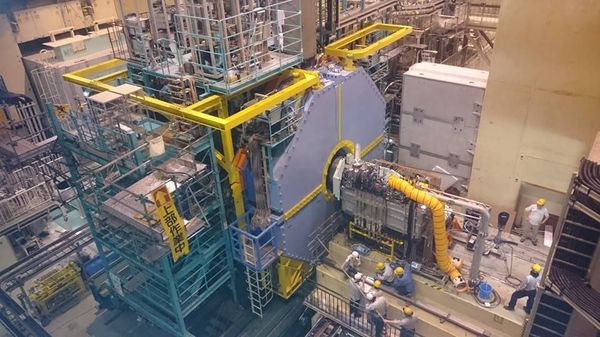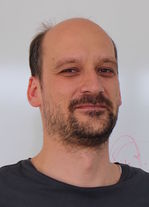
The Belle II experiment is in its final phases of construction
The Belle II experiment is in its final phases of construction at the KEK laboratory in Tsukuba. About one month ago, the detector has been "rolled in" (read the KEK press release) to its final position, with its center located in the point where intense beams of electrons and positrons will produce the first collisions at the beginning of year 2018.
While there are still many months before the SuperKEKB accelerator will resume operations, the physicists of the Belle II collaboration are very busy in these days for the start of the Global Cosmic Run (GCR). The general idea of this data taking run, which will extend through the Summer, is to exploit the cosmic rays (the natural flux of elementary particles that the Sun and other astrophysical sources produce) to test our equipment.
The Belle II detector is a very complex apparatus consisting of several sub-detectors responsible for the precise tracking of charged particles, the identification of their nature, the detection of neutral particles and measurement of their energy. Each of these subdetectors has been built and tested separately from the others; the GCR is the first real opportunity for all these different subsystems to start working as a single experiment.
What the Collaboration expects to achieve during the GCR are a full test of the Data Acquisition system, a calibration of many fundamental parameters, and a general idea of the performance of the detector.
Nagoya University is heavily involved in the activities of the GCR, in particular for what concerns the TOP counter
The members of Nagoya University, Kobayashi-Maskawa Institute (KMI) and its World Research Unit are heavily involved in the activities of the GCR, in particular for what concerns the TOP (Time Of Propagation) counter, the subdetector that is responsible for the correct identification of pion and kaon particles. The Nagoya team, lead by Prof. Toru Iijima, had a major responsibility in the design and construction of the TOP counter, in the development of its photodetectors (the MicroChannel Plate Photo Multiplier Tubes, built by Hamamatsu Photonics), and in the early tests of the apparatus. KMI members Alessandro Gaz, Yosuke Maeda, and Kodai Matsuoka are involved in the early tests and analysis of the first data of the TOP counter, while KMI Visiting Professor Peter Krizan from Ljubljana is Technical Coordinator of the Belle II Experiment.
The GCR will not only consist in a technical challenge, but it will also be a major step forward in the construction of a truly international Collaboration, consisting of about 750 physicists and technicians from 23 different countries. The Belle II members will get closer and closer in working towards a common goal and in sharing the excitement for a new scientific adventure that is about to begin.
(Written by Alessandro Gaz, KMI)
 Alessandro Gaz received his PhD in High Energy Physics in 2008 at the University of Padova, with a thesis on effects of matter-antimatter asymmetry in the oscillation of B mesons at the BaBar experiment. He continued these studies as a postdoc of the University of Colorado before moving to CERN in 2010, where he joined the CMS experiment, searching for possible evidences of supersymmetric particles produced at the Large Hadron Collider. He joined the KMI as associate professor in January 2016, collaborating in the Belle II experiment. His current research interests include particle identification techniques, time-dependent matter-antimatter asymmetries and effects of New Physics in rare B-meson decays.
Alessandro Gaz received his PhD in High Energy Physics in 2008 at the University of Padova, with a thesis on effects of matter-antimatter asymmetry in the oscillation of B mesons at the BaBar experiment. He continued these studies as a postdoc of the University of Colorado before moving to CERN in 2010, where he joined the CMS experiment, searching for possible evidences of supersymmetric particles produced at the Large Hadron Collider. He joined the KMI as associate professor in January 2016, collaborating in the Belle II experiment. His current research interests include particle identification techniques, time-dependent matter-antimatter asymmetries and effects of New Physics in rare B-meson decays.
Related Articles
Links
Since 2014, Nagoya University has supported researchers in forming promising international research hubs under the "Program for Promoting the Enhancement of Research Universities."
"World Research Unit for Heavy Flavor Particle Physics" has adopted as a cutting-edge international research unit under the program since 2014.
→http://aip-nagoya.com/ru/english/menu_b/index.html